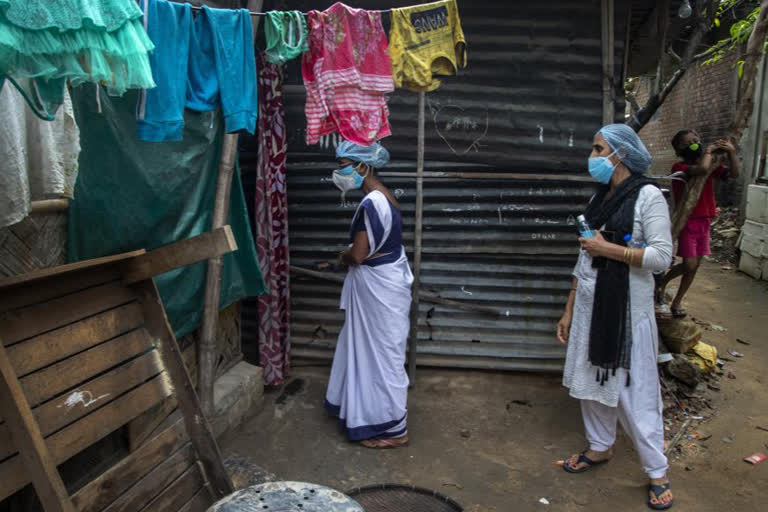Hyderabad/Lucknow: A recent report published by the World Health Organisation (WHO) India office mentioned a five-day house-to-house testing campaign launched by India's most populous state Uttar Pradesh to contain the transmission of the Covid-19 virus in rural areas by ramping up testing, treatment and contact tracing. However, the field visits by ETV Bharat journalists and analysis of Covid testing data tells a completely different story. The state grabbed international media attention after the dead bodies of suspected Covid patients were found floating ashore on the banks of river Ganga in Gazipur district of Uttar Pradesh.
The five-day testing campaign, which was supported by WHO India, aimed to cover 97,941 villages in 75 districts, showed no noticeable improvement in the scale of testing according to the testing data publicly available on https://www.covid19india.org/ and field visits and interviews of the village residents, health workers conducted by ETV Bharat journalists.
The WHO India report titled, ‘UTTAR PRADESH Going the last mile to stop COVID-19’ stated that the state government deployed 141,610 teams and 21,242 supervisors from the state health department for this activity to ensure all rural areas were covered.
Read:|WHO donates 100 oxygen concentrators to Rajasthan govt
“WHO, which supported the Uttar Pradesh government in training and micro-planning for the activity, now has field officers on the ground to monitor and share real-time feedback with the government for immediate corrective action to ensure quality,” said the WHO in an article published on its website on May 7.
The UN health body said: “On the inaugural day, WHO field officers monitored over 2,000 government teams and visited at least 10,000 households.”
However, the data available on https://www.covid19india.org/state/UP showed no noticeable increase during the five day campaign period which started on May 5.
In fact, the daily Covid testing in Uttar Pradesh was at a higher level at the start of the month of May than during the five-day campaign supported by the WHO.
According to the Covid19 India website, which is a crowdsourced initiative and widely referred in media reports, Uttar Pradesh conducted 2,66,619 tests on May 1, and 2,97,385 tests on May 2 before it registered a decline on May 3 when it conducted 2,29,613 tests and 2,08,564 tests on May 4.
If each of these 141,610 teams had conducted just two tests in a day then the number of Covid tests should have gone up by 283,220 tests per day during the five-day activity period, from some 2,30,000 tests a day to over 5,10,000 tests a day.
However, according to the data available on the site, Uttar Pradesh conducted 2,32,038 tests on the inaugural day, May 5. During the next four days, the state conducted 2,26,112 tests on May 6, 2,41,403 tests on May 7, 2,24,529 tests on May 8 and 2,29,595 tests on May 9.
Read:|India's COVID situation hugely concerning: WHO Chief
Between May 5 to May 9, Uttar Pradesh conducted over 11,52,000 tests, on an average little over 2,30,000 tests a day. Whereas, before the start of the Covid testing activity in rural areas of UP, in the first two days of the month, Uttar Pradesh conducted over 2,82,000 tests a day.
In its article, the WHO said: “Each monitoring team has two members, who visit homes in villages and remote hamlets to test everyone with symptoms of COVID-19 using Rapid Antigen Tests (RAT) kits. Those who test positive are quickly isolated and given a medicine kit with advice on disease management. All the contacts of those who test positive are quarantined and tested using an RT-PCR at home by a rapid response team.”
ETV Bharat’s Ground Report
Subsequent to the publication of the article by WHO, ETV Bharat's reporters in Uttar Pradesh reached out to residents, village chiefs and health workers in various villages and concerned authorities to report the ground reality. The WHO report had featured a photograph of its team at Sipahiya in the Barabanki district. Apart from visiting other districts, ETV Bharat's reporters visited Sipahiya village of Barabanki as well.
In Barabanki local people confirmed that a WHO team and health workers visited the Sipahiya village. The visit has been more of an awareness campaign than a house to house testing process.
"A team of people, the Chief Medical Officer (CMO) and District Magistrate (DM) visited the village and asked people if anyone is suffering from fever, cough, or cold. They visited some houses but no tests were conducted," said Sumeri Lal, a local resident.
Neelam, an ASHA health worker in Sipahiya village said as part of the five-day campaign, a health camp was set up at the local primary school.
"I get a notification when the tests are to be conducted. Then we call the people from the village and take them for the test," she said.
Read:|Religious and political events among factors that accelerated COVID-19 transmission in India: WHO
"Asha workers have created awareness so now people are coming to the vaccine centre. They were not coming earlier. Continuous monitoring is being done. 150 people have given samples in Sipahia, out of which only one person was found infected. Others were fine," said Dr. Kailash Shastri, Superintendent,Community Health Care centre, Dewan in Barabanki district.
Ghazipur
